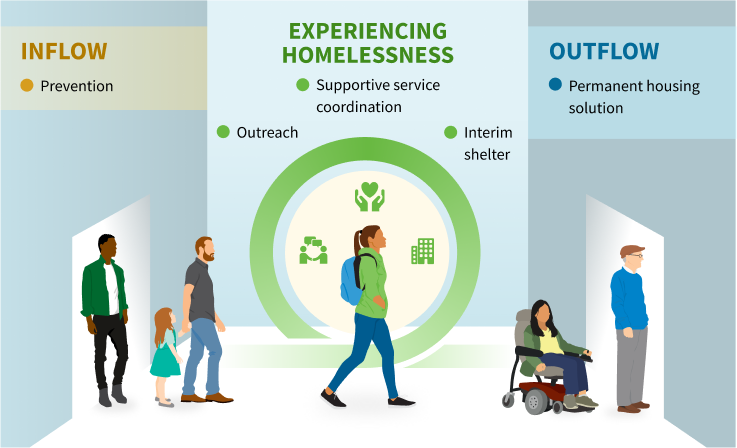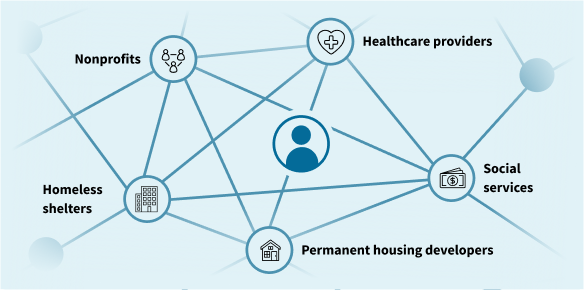Ending homelessness requires big, bold steps
California is targeting the immediate homelessness crisis and its root causes. Our goal is a future in which homelessness is rare, brief, and prevented whenever possible. To do this, we're making unprecedented investments in strategies that work.

Investing big
Ending homelessness is a big challenge, and we need big investments to match. Our investments this year are 10 times as large as they were 5 years ago.
California has stepped up funding for homelessness
Budget allocations for homelessness in billions of dollars
These funds will provide more than 55,000 new housing units and treatment slots.
Investing in communities
We’re directing these investments to our local partners. Find out how much funding is going to communities near you.
Funding for major programs by county
Making progress
Our investments are already having an impact. Over the last 3 years, California has:
- Served 25% more people experiencing homelessness.
- Added 32,000 more beds. This figure represents:
- An 11% increase in permanent supportive housing beds, and
- 65% of new shelter beds nationwide.
California leads the nation in creating new housing for people experiencing homelessness
Total change in bed capacity per 1000 residents from 2018-2021
New programs are making a difference
PROJECT ROOMKEY
has provided temporary housing for over 59,000 Californians.
Check Project Roomkey's current occupancy rateCOVID-19 RENT RELIEF
has helped over 350,000 households keep their housing.
Find more in the COVID-19 rent relief dashboardMore permits for housing development
Increasing our supply of affordable housing is essential to ending homelessness. That's why we're issuing more permits for housing development.
California is increasing permits to build more housing
Total units permitted by year
Progress happens everyday
While there are persistent challenges, people are being served and housed everyday. There’s constant work happening behind the scenes to help people stay in their homes. We’re using proven strategies to help people on their journey to permanent housing. Yet when there’s a flow of people both entering and exiting services, it's hard to notice any change.

We still have a long way to go. But we know our investments are making a difference and our strategies are working.
Strategies that work
We invest in a “Housing First” approach because evidence shows it works. This approach recognizes that services are more effective when people have secure housing. Our strategies combine housing supports with services customized to each person's experience.
Prevention
Provide supports so people can stay in their homes
→ Find out how rent relief helped people struggling in Santa Clara
Outreach
Build relationships with people without permanent housing
Connect people to critical services and safe shelter
→ Learn how people moved from an encampment to permanent housing in Santa Barbara
Interim housing
Provide temporary safe housing to meet pressing needs
Connect people to services and permanent housing options
→ Watch this video about people who got temporary housing and supports through Project Roomkey
Permanent housing
Access to housing that is stable and affordable
Connect people to services and supports to maintain their housing
→ Learn how unused buildings became permanent housing for Native Americans in Lake County through Homekey
Connect people to services that support their individual needs and journey to permanent housing
→ Watch this video about CalAIM’s efforts to extend healthcare and services to communities
Learn more about these strategies in the Action Plan for Preventing and Ending Homelessness in California.
Service delivery at the local level
We provide the funds so local partners can deliver the services. Local partners know their communities and their needs best.
Funding for major programs by county
Many local partners work together to provide a range of services so they can meet the needs of each person.

Addressing the challenge and inequities
For decades, investment in housing and services lagged, putting more people at risk. Now, we're turning the tide of homelessness by funding the services people need.
Too many Californians grapple with homelessness
Over 160,000 Californians experience homelessness according to 2021 one-night estimates. This includes:
- People with health issues
- Families with children
- Youth and students
- Older adults
Homelessness is not felt equally
Homelessness in California reflects stark racial inequities and impacts of systemic racism. Past investments haven't met the needs of marginalized groups. As a result, they experience homelessness at a disproportionate rate.
30%
Black people make up 6% of the state’s population yet represent 30% of people experiencing homelessness.
3x
Hispanic people are 3 times more likely to report worrying about becoming homeless than white people in California.
Each person's experience is different
A variety of factors can lead to housing instability, and people may face more than one.
Everyone deserves housing no matter what challenges they face. Understanding each person's experience is critical to aligning services to their needs. Some may need:
- Help with rent to prevent losing their housing
- Help finding and securing temporary or permanent housing
- Housing paired with robust supportive services

I believe [the Homekey program] saved my life. It’s also enabled us some time and space to improve my health and start working on a positive, realistic plan to regain a home and give back to society.
—Resident of the Homekey program
Find more stories about housing needs in the statewide housing plan, A Home for Every Californian.
Housing affordability is a key driver
Finding housing that's affordable in California is a challenge. Californians' incomes have not risen at the same rate as housing costs. As a result, many people are struggling to afford housing, and may be at risk of losing their housing.
Rents in California have risen much faster than incomes
Percent chance since 2001, adjusted for inflation
Everyone deserves housing
All Californians deserve a safe and stable place to call home. To end homelessness, and inequities embedded in it, we’re making big investments that:
- Address the broad and diverse range of people’s needs,
- Target funding to affected communities to maximize impact, and
- Ensure local partners’ success in service delivery and outcomes.

